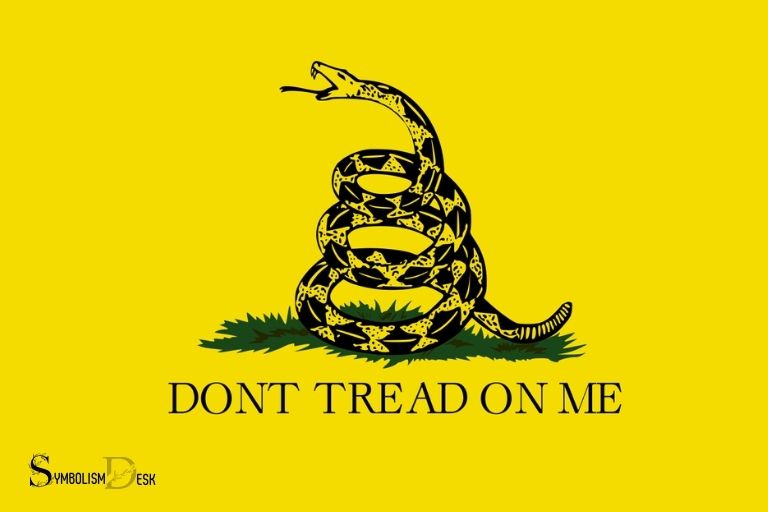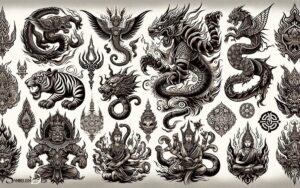What Does the Don’t Tread on Me Symbol Mean: Freedom!
The “Don’t Tread on Me” symbol, also known as the Gadsden flag, is a historical American flag representing the fight for freedom and independence from tyranny and oppression.
The “Don’t Tread on Me” symbol was designed by Christopher Gadsden, a Continental Army Colonel, in 1775. It features a yellow field with a coiled rattlesnake and the motto “Don’t Tread on Me” beneath it.
The symbol was adopted by the Continental Marines and has since become an iconic representation of American patriotism, often used by various political and social movements advocating for limited government intervention and individual liberties.
The rattlesnake in the “Don’t Tread on Me” symbol was chosen for its unique characteristics and resilience. It was considered a powerful symbol of American identity, as it is only found in North America.
The rattlesnake warns its predators with its rattle before striking, symbolizing the American spirit – that they will not seek trouble, but will fiercely defend themselves if threatened.
Overall, the Gadsden flag serves as a powerful reminder of the country’s fight for independence and the values upon which it was founded.
Interpretation and Significance of “Don’t Tread on Me” Symbol
| Symbol Element | Meaning |
|---|---|
| Coiled Rattlesnake | Represents vigilance, readiness to defend, and the potential for danger if provoked |
| “Don’t Tread on Me” Text | A warning against infringing on individual liberties and rights |
| 13 Rattles | Symbolizes the 13 original colonies of the United States |
| Yellow Background | Represents the Gadsden flag background, a symbol of freedom and liberty |
Key Takeaway

Five Facts About: The “Don’t Tread on Me” Symbol
The Origin Of The Don’t Tread On Me Symbol
The don’t tread on me symbol is one of the most iconic and recognizable symbols in american history.
It’s commonly associated with the american revolution and is a symbol of american independence and freedom. But where did it come from?
In this blog post, we’ll take a closer look at the origins of the don’t tread on me symbol and its significance during american colonization.
A Brief History Of The Symbol
- The don’t tread on me symbol features a coiled snake on a yellow background, with the words “don’t tread on me” written underneath.
- The symbol was created in 1775 during the american revolution, as a response to british taxation and oppression.
- It was designed by christopher gadsden, a politician and general in the continental army.
- The coiled snake was inspired by a famous cartoon published in benjamin franklin’s pennsylvania gazette in 1754, which featured a snake cut into pieces, with the words “join, or die” written underneath.
- The symbol quickly became a rallying cry for american revolutionaries and was often featured on flags, banners, and other patriotic paraphernalia.
The Importance Of The Symbol During American Colonization
- The don’t tread on me symbol was a powerful symbol of american resistance during a time of great social upheaval and political unrest.
- It represented a rejection of british authority and a reaffirmation of american independence and freedom.
- The symbol was often used by american patriots and soldiers to express their solidarity and determination in the face of british oppression.
- It was also a symbol of american resilience and perseverance, reminding colonists that they were capable of overcoming even the greatest of challenges.
The don’t tread on me symbol is an enduring icon of american history and a potent reminder of the struggles and triumphs of the american revolution.
Its powerful symbolism continues to inspire and motivate people around the world who value freedom, independence, and self-determination.
Interpretation Of The Don’t Tread On Me Symbol
The Symbol’S Significance In The Libertarian Movement
The don’t tread on me symbol is a significant feature of the libertarian movement. It is a direct representation of the libertarian values and principles of individual liberty, self-determination, and limited government.
Here are some key points explaining the symbol’s significance in the libertarian movement:
- The symbol originated during the american revolution and was used as a representation of the fight against british tyranny and oppression.
- It has since been adopted by the libertarian movement as a symbol of resistance against government overreach and the violation of individual rights.
- The symbol is often used in protests and rallies to demonstrate the belief that the government should not interfere with personal freedom and autonomy.
The Symbol’S Use By Different Groups And Organizations Over Time
The don’t tread on me symbol has transcended its original meaning and has been adopted by various groups and organizations over time.
Here are some key points explaining the symbol’s use by different groups and organizations over time:
- The symbol has been used by groups with diverse ideologies, such as the tea party movement, alt-right groups, and second amendment supporters.
- It has been used by corporations and businesses, such as nike, as a marketing strategy to appeal to consumers who identify with the symbol’s values.
- The symbol has even been used in pop culture, appearing in movies and music, as a representation of rebellion and defiance.
The don’t tread on me symbol holds significant meaning in various groups and organizations, each interpreting it in their own way.
However, its roots in the american revolution and its adoption by the libertarian movement make it a symbol of resistance against government overreach and the violation of individual rights.
The Symbol’s Continued Relevance Today
The don’t tread on me symbol has a rich history that dates back to the revolutionary era.
The symbol, also known as the gadsden flag, depicts a coiled rattlesnake on a yellow background with the words “don’t tread on me” written underneath.
The symbol continues to have relevance today and is seen in contemporary politics, popular culture, and merchandise.
In this blog post, we will discuss the symbol’s continued relevance today, with a focus on its use in contemporary politics and popular culture.
The Symbol In Contemporary Politics
The don’t tread on me symbol has been adopted by various political groups to express their beliefs and values.
Below are key points about its use in contemporary politics:
- The symbol is often associated with libertarianism and is a symbol of resistance against government intervention and infringement on individual rights.
- The symbol has been used by political parties such as the tea party and is commonly seen at political rallies and protests.
- Some individuals have criticized the symbol’s use in politics, arguing that it has been co-opted by extremist and far-right groups.
The Symbol’S Use In Popular Culture And Merchandise
The don’t tread on me symbol has become a popular motif in mainstream culture and merchandise.
Below are key points about its use in popular culture and merchandise:
- The symbol has been used in clothing and merchandise, such as t-shirts, hats, and bumper stickers.
- The symbol has been featured in movies, tv shows, and video games, serving as a visual shorthand for rebellion and resistance.
- Due to its popularity, the symbol has been parodied and used in humorous contexts.
The don’t tread on me symbol continues to have relevance today and is seen in contemporary politics, popular culture, and merchandise.
While its origins are rooted in the revolutionary era, the symbol continues to be a potent expression of resistance against government intervention and infringement on individual rights.
The Meaning Of The Don’T Tread On Me Symbol
Exploring The Symbol’S Origins
The don’t tread on me symbol is a popular icon in american culture that embodies the principles of individualism, freedom and resistance. Many Americans see the don’t tread on me symbol as a powerful statement against government overreach and the infringement of personal liberties. It has become synonymous with the spirit of rebellion and defiance often associated with the founding of the United States. The flashing tire symbol meaning serves as a reminder to stand up for one’s beliefs and resist any form of oppression.
Its history traces back to the american revolution, when it was first used as a political message to rally the colonists against the british.
Here are the key points about the symbol’s origins:
- The symbol was created by christopher gadsden, a general and statesman, who designed the flag with a coiled rattlesnake and the words “don’t tread on me.” The coiled snake, with its rattle poised to strike, conveyed a warning to anyone who threatened the colonies’ freedom.
- The flag was adopted by the continental marines in 1775 as their first official standard, and it quickly became associated with the spirit of independence and defiance.
- During the american revolution, the flag was flown on the ships of the continental navy as a symbol of rebellion against the british. It was used in battles and became a popular icon of the american resistance.
- The symbol regained popularity in modern times during the tea party movement, which used the flag as a symbol of protest against government overreach and tyranny.
The don’t tread on me symbol has a rich history that goes back to the founding of america, and it continues to inspire people who stand up for their rights and freedoms.
The Rattlesnake And Its Meanings
From bumper stickers to t-shirts, the “don’t tread on me” flag is an iconic symbol of american history and patriotism.
But what is the meaning behind the image of a coiled rattlesnake? And how did it come to represent the spirit of american independence?
Let’s explore the historical symbolism of the snake in america and the connection between the snake and the “don’t tread on me” phrase.
The Historical Symbolism Of The Snake In America
- The rattlesnake has long been a powerful symbol in america, appearing on flags, coins, and military insignia.
- Benjamin franklin popularized the image of a coiled rattlesnake as a symbol of american independence in the 1750s.
- The snake represented the american colonies, each segment of its body representing a different colony, united and ready to strike against their enemies.
- The rattlesnake’s deadly reputation made it a perfect symbol for the american military, appearing on the gadsden flag, the first american flag to feature a snake and the “don’t tread on me” phrase.
The Connection Between The Snake And The Don’T Tread On Me Phrase
- The “don’t tread on me” phrase originated from a flag created by american general and statesman christopher gadsden during the american revolution.
- The flag featured a coiled rattlesnake, ready to strike, with the words “don’t tread on me” written underneath.
- The phrase represents the spirit of american independence and the belief that the american people will not stand for oppression or tyranny.
- Today, the flag and its associated phrase continue to be used as a symbol of american freedom and defiance against injustice.
The Significance Of The Colors Used In The Symbol
The don’t tread on me flag, also known as the gadsden flag, is a symbol of american patriotism that originated in the revolutionary war era.
The yellow banner with a coiled snake and the phrase “don’t tread on me” has become a recognizable emblem for many groups in the united states.
The flag’s use and interpretation have evolved over time, but the meaning of the colors used in the symbol has remained consistent.
In this blog post, we will explore the significance of the don’t tread on me symbol’s colors.
The Origins And Meanings Of The Yellow Background And Bold Lettering:
- The yellow background represents the sun and the new beginning of a new era of liberty and freedom. It symbolizes hope for a better future.
- The bold lettering of “don’t tread on me” is symbolic of the american revolutionary war spirit, encouraging independence, and rejecting british authority.
The Incorporation Of Blue And Red Stripes:
- The incorporation of blue and red stripes in the flag was significant and carried meaning. The blue color represents loyalty, justice, and perseverance, while the red stripes represent the blood of those who shed it for their country and the valor of the american people.
- The blue and red stripes on the flag signify the thirteen colonies that fought for independence from great britain.
The don’t tread on me symbol represents a proud american spirit that values freedom and independence. Its colors play a significant role in conveying the ideas of liberty and patriotism. Through the years, the symbol has adapted and evolved, but its message has always remained strong.
Analysis Of The Symbol’S Impact On American Society
Throughout american history, various symbols have represented different beliefs and values. The don’t tread on me symbol, also known as the gadsden flag, is one such symbol that has had an immense impact on american society.
In this section, we will analyze the symbol’s role in american nationalism.
The Symbol’S Role In American Nationalism
The don’t tread on me symbol played a critical role in american nationalism from the beginning of the country’s history.
Here are some key points:
- The symbol represents the desire for individual liberty and resistance to tyranny, which are fundamental values that founded the american nation.
- The symbol gained greater prominence during the american revolution when it was used to encourage americans to fight for their independence.
- Over time, the symbol has been adopted by various groups, from libertarians to tea party activists, to express their support for limited government and individual freedom.
- The symbol has also been used as a statement of resistance against government overreach, particularly related to issues like taxes and gun control.
Overall, the don’t tread on me symbol has become a powerful emblem of american nationalism, uniting people with different political beliefs around a shared ideal of individual liberty and resistance to government oppression.
Based on its significance and broad appeal, it’s no wonder the don’t tread on me symbol continues to be popular in america today.
The Symbol And The American Revolution
The don’t tread on me symbol is an iconic representation of america’s founding principles of freedom and individual liberty. But what does it really mean, and how does it connect to the american revolution? The symbol, featuring a coiled rattlesnake and the phrase “Don’t Tread on Me,” was created during the American Revolution as a message to the British that the American colonies would not be pushed around. It still resonates today as a statement of resistance against oppression and a reminder of the importance of personal autonomy. The understanding tire snowflake symbol is a contemporary version of this sentiment, representing the idea that individuals should not be controlled or manipulated. Both symbols serve as powerful reminders of the enduring value of personal freedom in American society.
Let’s take a closer look at the symbol’s history and significance, particularly its connection to the boston tea party and the revolution.
A Close Look At The Symbol’S Connection To The Boston Tea Party And The Revolution
The don’t tread on me symbol, which consists of a coiled rattlesnake on a yellow background, was first used by the american revolutionaries during the colonial era.
Here are some key points to consider:
- The symbol is closely associated with the boston tea party of 1773, where a group of american colonists, disguised as native americans, dumped 342 chests of tea into the boston harbor to protest against the british government’s unjust taxation policies.
- The coiled rattlesnake is a powerful visual metaphor, representing both danger and preparedness. The snake, a native species of america, was also seen as a symbol of resistance against british tyranny.
- The phrase “don’t tread on me” is a warning to would-be oppressors, reminding them that americans will not tolerate any encroachment on their freedom and rights.
- The symbol’s origins can be traced back to benjamin franklin and the philadelphia gazette, where it was first published in 1754 in a political cartoon called “join or die.” The cartoon depicted a segmented snake that, when pieced together, represented the colonies unified against the french and their native american allies.
The don’t tread on me symbol has come to represent the true spirit of american patriotism and a refusal to bow down to tyranny.
Its connection to the american revolution and the boston tea party is a powerful reminder of the sacrifices made by our forefathers to secure our freedoms.
As we continue to celebrate this symbol, let us also remember the values that it stands for–the values that make america great.
Modern Interpretations Of The Symbol
The Symbol’S Place In Contemporary Political Discourse
The “don’t tread on me” symbol has garnered much attention in recent years, specifically within the realm of contemporary political discourse.
Here are some key points to consider:
- The symbol is heavily associated with libertarian and conservative ideologies, particularly in the united states.
- It has been utilized as a banner for tea party rallies and merchandise, as well as being featured in political ads and speeches.
- Some individuals have used the symbol as a way to express their dissatisfaction with government overreach and infringements upon personal liberties.
- Others have argued that the symbol has been co-opted by right-wing extremist groups and has become associated with hate speech and xenophobia.
The Symbol’S Use By Different Groups With Different Beliefs
While the “don’t tread on me” symbol is most often associated with libertarian and conservative ideologies, it has been utilized by a variety of groups with differing beliefs.
Here are some key points to consider:
- The symbol has been used by members of various armed forces branches, often in relation to operation and mission patches.
- Some individuals use the symbol as a show of patriotism and american values
- Those within the lgbtq community have utilized the symbol to reclaim its meaning and turn it into a symbol of resistance against discrimination.
- It has also been used by environmental groups as a way to express support for conservation and protection of natural resources.
Criticism Of The Don’T Tread On Me Symbol
The don’t tread on me symbol is widely recognized as a symbol of liberty and freedom, particularly in the united states. However, like any symbol, it has its critics.
Here are some of the main criticisms of the don’t tread on me symbol:
Criticism As A Form Of Expression
Criticism is a form of expression that allows individuals to voice their opinions and ideas about a particular topic. In the case of the don’t tread on me symbol, criticism often centers around the symbol’s historical context and connotations.
Some argue that the symbol has been co-opted by far-right groups and has become associated with white nationalism and other forms of extremism.
Criticism Of Historical Context
The don’t tread on me symbol has its roots in the american revolution, when it was used as a banner by forces fighting for independence from great britain.
However, critics argue that the historical context of the symbol is often overlooked or misunderstood.
Some argue that the symbol was first used as a warning against native american attacks, and that its use in the revolutionary war was primarily symbolic.
Criticism Of Symbolic Value
Another criticism of the don’t tread on me symbol is that its meaning has been distorted over time.
While the symbol was originally meant to represent resistance against tyranny and oppression, some argue that it has been appropriated by groups with a more narrow agenda.
This has led some critics to argue that the symbol has lost its symbolic value and has become little more than a tool for promoting extremist beliefs.
Overall, while the don’t tread on me symbol continues to be an important symbol of liberty and freedom, it has also faced criticism from those who see it as a symbol of extremism and intolerance.
Regardless of one’s own views on the symbol, it is important to understand its historical context and the various interpretations that have been attributed to it over time.
The Symbol’s Controversial Connotations
The don’t tread on me symbol has been around since the american revolution and represents freedom and individual rights.
However, the symbol has been used in popular culture and politics in ways that have been controversial and divisive. Let’s take a closer look at the symbol’s controversial connotations.
Analyzing Criticism Of The Symbol’S Use In Popular Culture And Politics
While the don’t tread on me symbol has been a source of pride for many americans, it has also faced criticism in recent years. Some people view the symbol as divisive and associated with extreme political groups, like white supremacists.
Let’s take a look at some of the criticism and concerns.
- Critics argue that the don’t tread on me symbol has been hijacked by far-right groups and has become associated with hate speech, racism, and intolerance.
- Others argue that the symbol has become a sign of resistance against the government and has been co-opted to represent anti-government sentiment.
- There are also concerns that the symbol’s use has become overly commercialized, with companies using it to sell merchandise without any understanding of its historical significance.
The Role Of The Don’T Tread On Me Symbol In Polarizing American Society
The don’t tread on me symbol has become a polarizing issue in american society. While some embrace it as a symbol of freedom and individual rights, others view it as a symbol of intolerance and division.
Here are some of the factors that contribute to this polarization:
- The symbol’s historical significance and original meaning have been lost or distorted over time due to its various uses.
- The increasing politicization of the symbol has led to strong emotions on both sides of the debate.
- Social media has played a significant role in spreading and amplifying this division, with people using the symbol to support their political beliefs and attack those who disagree.
While the don’t tread on me symbol may have started as a symbol of american independence, its use in popular culture and politics has led to controversy and polarization.
The symbol still carries different meanings for different people, but it is essential to remember its true historical significance and use it responsibly.
What Does the Forward Slash Symbol Represent?
The meaning of forward slash symbol, also known as a solidus or slash, varies in different contexts. In computing, it often represents a division in URLs or as a file system separator. In linguistics, it can indicate a choice, as in and/or. Additionally, some programming languages use it to indicate alternatives or options.
FAQ About The Don’t Tread On Me Symbol Mean
What Is The Meaning Of The Don’t Tread On Me Symbol?
The “don’t tread on me” symbol represents independence, individual rights, and self-governance.
What Is The History Of The Don’t Tread On Me Symbol?
The “don’t tread on me” symbol was created in 1775 by christopher gadsden during the american revolution.
What Does The Snake On The Don’t Tread On Me Symbol Represent?
The snake on the “don’t tread on me” symbol represents the american colonies’ determination to defend their rights.
Is The Don’t Tread On Me Symbol Related To Any Political Ideology?
The symbol is often associated with libertarianism and the tea party movement in modern times.
Why Is The Don’t Tread On Me Symbol Controversial?
The symbol has been controversial due to its use by certain extremist groups and the association with the confederate flag in american history.
Conclusion
The don’t tread on me symbol carries a rich history that extends beyond its use in modern politics.
It holds a complex meaning that resonates with people from all walks of life, representing everything from freedom to resistance against oppression.
As we dig deeper into its origin, we realize that this flag holds a pivotal place in the timeline of american history.
As society continues to evolve, this symbol remains relevant as a reminder of our deep-rooted patriotism and fervent desire for liberty.
Whether seen on bumper stickers, t-shirts, or flying proudly in front of homes, the don’t tread on me symbol serves as a tangible link between our past and our present-day values.
Ultimately, this symbol is a call to action, urging citizens to stand up for their beliefs and to fight against any encroachment on their individual freedoms. It serves as a reminder that the power to protect democracy and ensure justice lies within the hands of the people. The green lantern symbol meaning, in this context, represents the light of hope and resilience that guides individuals through dark times. By uniting under this emblem, communities can channel their collective strength to confront challenges and safeguard their shared values.
So, let us embrace the don’t tread on me symbol, and let it serve as a powerful reminder of our proud history of resistance and our unwavering commitment to democracy and freedom.






